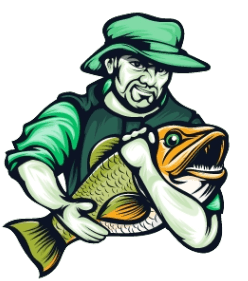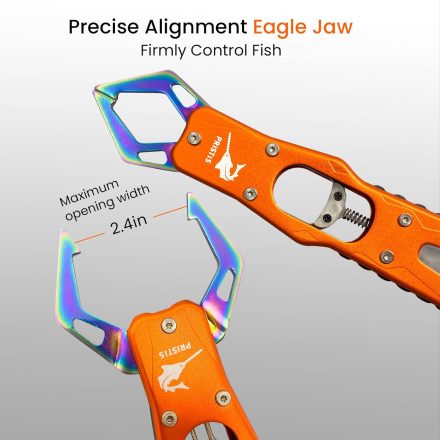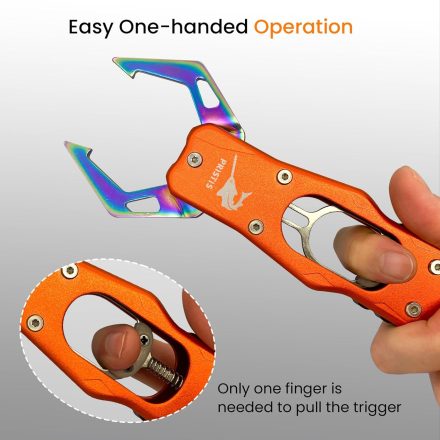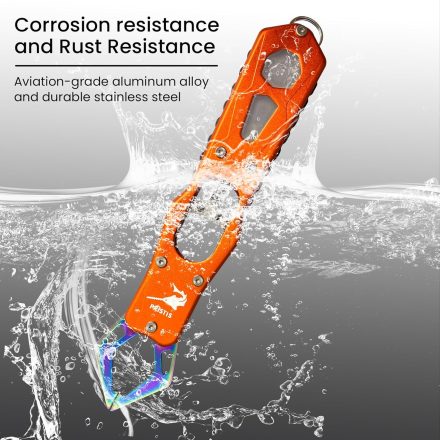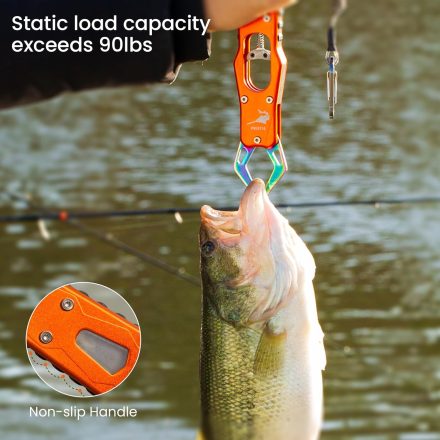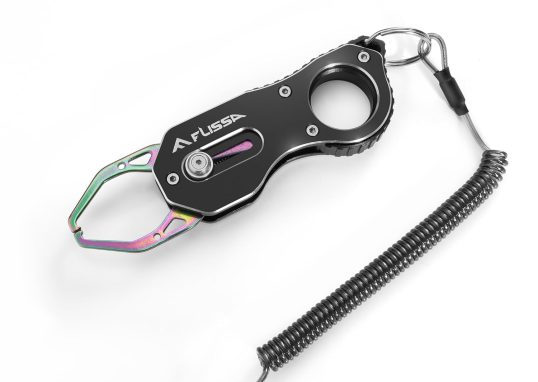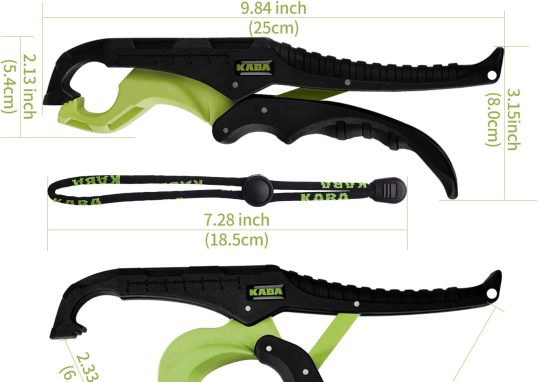
Fishing gripper is a handheld tool designed to securely grasp a fish by its mouth, allowing anglers to handle the fish safely. The primary purpose of this tool is to minimize physical contact with the fish, reducing stress and potential injury, particularly in catch-and-release fishing. Fishing grippers come in various designs and are made from different materials, each offering specific advantages depending on the fishing environment and target species.
Click for Buying
Types of Fishing Grippers
1.Lip Grippers
They are designed to clamp onto the fish’s lower jaw, providing a firm hold without penetrating the skin. These grippers are typically used for larger species, where a secure hold is necessary to prevent the fish from slipping away. Lip grippers often come with a built-in scale, allowing anglers to weigh their catch without removing it from the gripper.
2.Trigger Grippers
Trigger grippers feature a trigger mechanism that opens and closes the gripping jaws. These grippers offer more precise control, making them ideal for smaller fish or species with delicate mouths. The trigger mechanism allows for one-handed operation, making it easier to handle the fish while managing the rod and reel.
4.Pistol Grippers
Pistol grippers are named for their pistol-like handle, which provides a comfortable and ergonomic grip. The jaws of the gripper are controlled by a trigger, similar to trigger grippers. Pistol grippers are often used in saltwater fishing, where larger and more powerful fish require a robust tool for safe handling.
5.Floating Grippers
Floating grippers are designed to float on water, preventing accidental loss if dropped. These grippers are typically made from lightweight materials like plastic or aluminum, ensuring they remain buoyant. Floating grippers are particularly useful in kayak or shore fishing, where dropping a tool into the water can result in its permanent loss.
6.Rotating Grippers
Rotating grippers feature jaws that can rotate 360 degrees, allowing for better positioning when handling the fish. This feature is especially useful when dealing with fish that twist or thrash when being handled. The rotating mechanism reduces the risk of injury to the fish by allowing the angler to maintain control without exerting excessive force.
Materials Used in Fishing Grippers
The materials used in the construction of fishing grippers play a significant role in their durability, weight, and performance. Common materials include:
- Stainless Steel
Stainless steel is a popular choice for fishing grippers due to its strength, corrosion resistance, and durability. Stainless steel grippers are particularly well-suited for saltwater fishing, where exposure to salt and moisture can cause other materials to corrode. These grippers are typically heavier, providing a solid and reliable grip on larger fish.
- Aluminum
Aluminum is a lightweight and corrosion-resistant material, making it ideal for fishing grippers. Aluminum grippers are easy to handle and reduce fatigue during extended fishing sessions. They are also resistant to rust, making them suitable for both freshwater and saltwater environments.
- Plastic
Plastic fishing grippers are lightweight and often float on water, making them a practical choice for shore or kayak fishing. While they may not offer the same durability as metal grippers, plastic grippers are affordable and easy to replace if lost. High-quality plastic grippers are reinforced to provide adequate strength for handling larger fish.
- Composite Materials
Composite materials combine the advantages of different materials, such as the strength of stainless steel and the lightweight nature of aluminum. These grippers are designed to offer a balance of durability, weight, and performance, making them versatile tools for various fishing conditions. Click For REEL.
Benefits of Using a Fishing Gripper
The use of a fishing gripper offers numerous benefits, both for the angler and the fish:
- Fish Safety
One of the primary advantages of using a fishing gripper is the safety it provides to the fish. By minimizing direct contact with the fish’s body, the gripper reduces the risk of removing the protective slime layer, which can lead to infections and other health issues. Additionally, the gripper’s design helps prevent injury to the fish’s mouth and gills, which are vital for its survival after release..
- Efficient Catch-and-Release
For anglers practicing catch-and-release, a fishing gripper is an essential tool. It allows for quick and efficient handling of the fish, minimizing the time it spends out of the water. This, in turn, increases the fish’s chances of survival after release. The gripper’s design also enables the angler to weigh the fish without removing it from the water, further reducing stress on the fish.
- Ease of Use
Fishing grippers are designed for ease of use, with most models offering one-handed operation. This is particularly beneficial when dealing with larger or more powerful fish, as the angler can maintain control of the fish while managing other equipment. The ergonomic design of many grippers also reduces hand fatigue during prolonged use.
- Versatility
Fishing grippers are versatile tools that can be used in a variety of fishing environments, from freshwater lakes and rivers to saltwater oceans. Their ability to handle a wide range of fish species makes them an indispensable tool for both amateur and professional anglers.
Click for Buying
Maintaining Your Fishing Gripper
Proper maintenance of your fishing gripper is essential to ensure its longevity and performance. Here are some tips on how to care for your fishing gripper:
1.Clean After Use
After each fishing trip, rinse your gripper with fresh water to remove any salt, dirt, or debris. This is particularly important for metal grippers, as saltwater can cause corrosion if not properly cleaned.
2.Dry Thoroughly
After cleaning, dry your gripper thoroughly with a clean towel. Avoid storing your gripper in a damp environment, as moisture can cause damage over time.
3.Lubricate Moving Parts
If your gripper has moving parts, such as a trigger mechanism, apply a light coat of lubricant to keep it functioning smoothly. Be sure to use a lubricant that is safe for use in aquatic environments, as some oils can be harmful to fish and the environment.
4.Inspect Regularly
Regularly inspect your gripper for signs of wear or damage. Check the jaws, trigger, and other components to ensure they are in good working condition. If you notice any issues, such as rust, corrosion, or loose parts, repair or replace the gripper as needed.
5.Store Properly
When not in use, store your gripper in a protective case or pouch to prevent damage. Keep it away from direct sunlight, extreme temperatures, and moisture, which can all cause deterioration over time.
Choosing the Right Fishing Gripper for Your Needs
Selecting the right fishing gripper depends on several factors, including the type of fishing you do, the species you target, and your personal preferences. Here are some considerations to keep in mind when choosing a fishing gripper:
- Target Species
Consider the size and strength of the fish you typically target. For larger, more powerful species, choose a sturdy, heavy-duty gripper made from stainless steel or aluminum. For smaller fish, a lighter, more delicate gripper may be sufficient.
- Fishing Environment
The environment in which you fish also plays a role in selecting the right gripper. If you fish in saltwater, choose a gripper made from corrosion-resistant materials like stainless steel or aluminum. For freshwater fishing, you may opt for a lighter material, such as plastic or composite.
- Ease of Use
Consider how easy the gripper is to use, particularly in challenging conditions. One-handed operation can be a significant advantage, especially when handling large or active fish. Look for a gripper with an ergonomic design that fits comfortably in your hand.
- Additional Features
Some grippers come with additional features, such as built-in scales, rotating jaws, or floating capabilities. These features can add convenience and versatility to your fishing experience. Consider which features are most important to you based on your fishing style.
- Budget
Fishing grippers are available at various price points, from budget-friendly plastic models to high-end stainless steel options. Determine your budget and choose a gripper that offers the best balance of quality and affordability.
Environmental Considerations
As anglers, it is essential to consider the environmental impact of our actions and the tools we use. Fishing grippers, when used responsibly, can contribute to sustainable fishing practices by minimizing harm to fish populations. Here are some ways to ensure that your use of a fishing gripper aligns with environmental conservation:
- Practice Catch-and-Release Responsibly
If you practice catch-and-release, use your fishing gripper to minimize the time the fish spends out of the water. Handle the fish gently and release it as quickly as possible to reduce stress and increase its chances of survival.
- Choose Environmentally Friendly Materials
Opt for fishing grippers made from environmentally friendly materials. Avoid grippers that contain harmful chemicals or coatings that could leach into the water. If possible, choose grippers made from recyclable materials or those with minimal environmental impact.
- Educate Others
Share your knowledge of responsible fishing practices with other anglers. Encourage the use of fishing grippers and other tools that promote fish safety and environmental conservation. By educating others, you can help protect fish populations and the ecosystems they inhabit.
Click for Buying
The Future of Fishing Grippers
As technology continues to advance, the design and functionality of fishing grippers are likely to evolve. Future developments may include:
- Smart Grippers
The integration of smart technology into fishing grippers could provide anglers with real-time data on their catch, such as weight, length, and even species identification. This information could be transmitted to a smartphone app, allowing anglers to track their catches and share them with others.
- Eco-Friendly Designs
As environmental concerns become increasingly important, manufacturers may develop more eco-friendly grippers made from sustainable materials. These grippers could be designed to have minimal impact on the environment, both during production and use.
- Enhanced Ergonomics
The design of fishing grippers is likely to continue evolving to provide better ergonomics and ease of use. Future grippers may feature adjustable handles, improved grip surfaces, and other innovations that make them more comfortable and efficient to use.
- Customizable Grippers
Customization options could allow anglers to tailor their grippers to their specific needs and preferences. This could include interchangeable jaws for different fish species, adjustable tension settings, and personalized designs.
Conclusion
The fishing gripper is an indispensable tool for modern anglers, offering numerous benefits in terms of safety, efficiency, and fish conservation. By understanding the different types of grippers, the materials they are made from, and how to use and maintain them properly, anglers can make the most of this essential tool. As technology and environmental awareness continue to shape the future of fishing, the fishing gripper is poised to evolve, offering even more innovative and sustainable solutions for anglers worldwide. Whether you are a seasoned pro or a beginner, a quality fishing gripper is a valuable addition to your fishing gear, helping you handle your catch with care and precision.
Click for Buying
